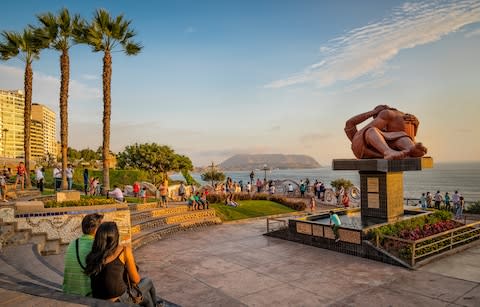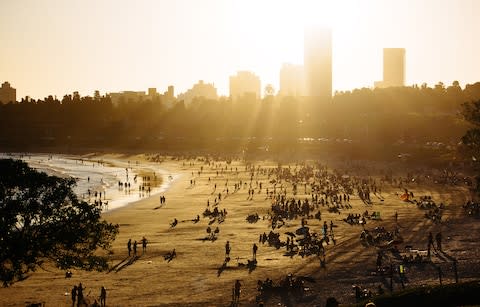Five must-see cities on a South America cruise

Forget a tick-list of sights – when visiting South America’s cities, it’s all about experiencing the Latin lifestyle. Hear the strains of samba in Rio, taste the tang of ceviche in Lima, and learn to tango – or watch the experts show off – in Buenos Aires. With many of the region’s most iconic metropolises – and some lesser-known gems – on the coast, a cruise is a great way to explore South America’s urban delights.
Buenos Aires
It’s been said that a porteño – as residents of the Argentine capital call themselves – is an Italian who speaks Spanish, lives like the French and wants to be English. But Buenos Aires brings Latin passion to its European heritage, with grand baroque architecture and colourful barrios, top notch pizza and superlative steak, café culture and street tango, nightlife that starts at 10pm and is still going at breakfast time, and one of the world’s most famously rowdy football clubs.
Visit working class La Boca for primary-coloured houses and artistic graffiti, and La Bombonera, the Boca Juniors stadium. In affluent, Beaux-Arts Recoleta you can pay your respects to Eva Peron at the labyrinthine cemetery. On any corner, you’ll find a parilla, with pretty much every part of a cow laid out on the vast open grill. Malbec will pair well with anything on the menu.
Rio de Janeiro
For a city of more than six million people, Rio’s natural beauty is still what smacks you in the face when you first arrive. Emerald forests snake up its urban mountains, sapphire waters edge its vanilla beaches, and distant peaks peek over its high-rise skyscrapers. Sure, it can be gritty, but this city lives life to the fullest, from the samba clubs of Lapa to the sands of Ipanema, packed with cariocas surfing, strolling and flirting.
Take in a show at the opulent Teatro Municipal, get tickets for a game at the Maracanã stadium, and book a tour of a favela – though it’s worth researching the last, and booking one using local guides who respect their communities. You’ll want to get some height too – ascend Corcovado to stand at the feet of Christ the Redeemer, and summit Sugarloaf Mountain. You can be brave and hike to the latter, or get the cable car – the views will take your breath away, even if you’ve gone for the lazy option.

Lima
It’s easy to see Lima as a late bloomer. The city has certainly ballooned – today there’s 30 times the number of residents there were in 1930. The capital has had a real resurgence in the last decade, its position at the spearhead of the Peruvian food scene tempting travellers to stay and explore rather than rush off to more aesthetically appealing spots. But between the skyscrapers and shantytowns you’ll spot palaces and mansions – evidence of Lima’s grand and storied past as the richest city in South America until the early 19th century.
Nowadays, streets are sprawling, traffic is chaotic and from June to September the city is often shrouded in heavy fog, but there’s plenty to love, from the cosmopolitan district of Miraflores, perched on top of crumbling cliffs, to colonial, Bohemian Barranco. Sightsee, by all means, but save time for eating – this is the place to try specialities from ceviche to cuy, as the Peruvians call guinea pig.

Santiago
This Cinderella of South American cities spent years in the shadow of Buenos Aires and Rio, but that means she’s the best kind of beauty – approachable, with no shred of arrogance. Reclining at the foot of the Andes, Santiago’s magnificent mountain backdrop brings drama to an architectural mash-up, modern tower blocks rubbing shoulders with colonial buildings.
The centre is compact and easy to visit, with an excellent Pre-Colombian art museum, and the idiosyncratic Cerro Santa Lucia. This urban outcrop was turned into a rather theatrical public park in 1872, when 150 prisoners were enlisted to build terraces, turrets and pathways, and now it offers one of the best views of the city. You’ll find street art and pavement cafes in the laidback barrios Lastarria and Bellavista, and the latter is also home to the house of poet Pablo Neruda, beautifully preserved as a museum.

Montevideo
Like Uruguay itself, Montevideo is laidback, liberal and low-key, providing a lovely counterpoint to the other cities on South American itineraries, which tend to the giant and frenetic end of the scale. The pint-sized old town is safe to wander around, browsing the shops and galleries on the many pedestrianized, tree-lined boulevards, enjoying the brightly-tinted facades and eclectic street art, and picking up souvenirs from the flea market on Plaza Matriz.
Its 14-mile ocean road, the Rambla, has the longest continuous pavement in the world, with sea views to one side and high-rise hotels on the other. Take a walk, or simply watch the world go by with a glass of Tannat, the spicy, smoky red wine signature to the country.

What to book
Want to leave winter behind? Balmoral leaves Southampton in January for a mammoth 70-night South American Exploration, circling Cape Horn before cruising back through the Panama Canal, with ports of call including Rio, Buenos Aires, Montevideo, Valparaiso (for Santiago) and Callao (for Lima). From £6,999pp, departs January 6, 2020 (fredolsencruises.com).
Don’t have long? Flit to the balmy east coast for a 10-day itinerary on Silver Shadow from Buenos Aires to Rio, calling at, among other ports, Montevideo. From £4,500pp, departs February 26, 2020 (silversea.com).


